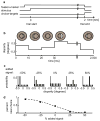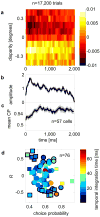Decision-related activity in sensory neurons reflects more than a neuron's causal effect
- PMID: 19270683
- PMCID: PMC2917918
- DOI: 10.1038/nature07821
Decision-related activity in sensory neurons reflects more than a neuron's causal effect
Abstract
During perceptual decisions, the activity of sensory neurons correlates with a subject's percept, even when the physical stimulus is identical. The origin of this correlation is unknown. Current theory proposes a causal effect of noise in sensory neurons on perceptual decisions, but the correlation could result from different brain states associated with the perceptual choice (a top-down explanation). These two schemes have very different implications for the role of sensory neurons in forming decisions. Here we use white-noise analysis to measure tuning functions of V2 neurons associated with choice and simultaneously measure how the variation in the stimulus affects the subjects' (two macaques) perceptual decisions. In causal models, stronger effects of the stimulus upon decisions, mediated by sensory neurons, are associated with stronger choice-related activity. However, we find that over the time course of the trial these measures change in different directions-at odds with causal models. An analysis of the effect of reward size also supports this conclusion. Finally, we find that choice is associated with changes in neuronal gain that are incompatible with causal models. All three results are readily explained if choice is associated with changes in neuronal gain caused by top-down phenomena that closely resemble attention. We conclude that top-down processes contribute to choice-related activity. Thus, even forming simple sensory decisions involves complex interactions between cognitive processes and sensory neurons.
Figures




References
-
- Logothetis NK, Schall JD. Neuronal correlates of subjective visual perception. Science. 1989;245:761–763. - PubMed
-
- Leopold DA, Logothetis NK. Activity changes in early visual cortex reflect monkeys’ percepts during binocular rivalry. Nature. 1996;379:549–553. - PubMed
-
- Britten KH, Newsome WT, Shadlen MN, Celebrini S, Movshon JA. A relationship between behavioral choice and the visual responses of neurons in macaque MT. Vis Neurosci. 1996;13:87–100. - PubMed
-
- Uka T, DeAngelis GC. Contribution of area MT to stereoscopic depth perception: choice-related response modulations reflect task strategy. Neuron. 2004;42:297–310. - PubMed
Publication types
MeSH terms
Grants and funding
LinkOut - more resources
Full Text Sources
Other Literature Sources

